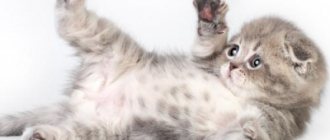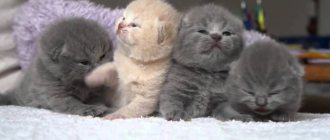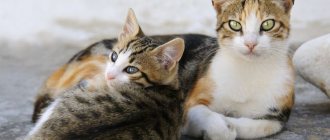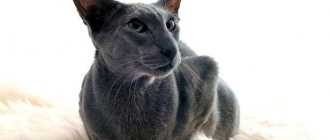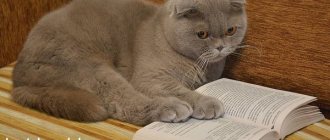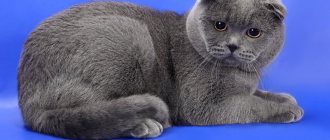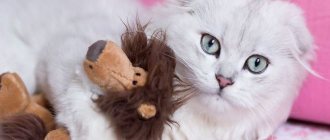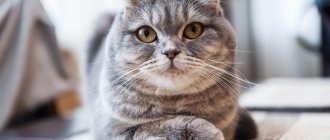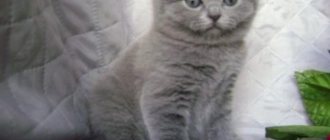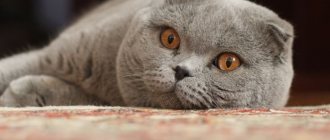The Scottish Straight cat (also called Scottish Straight) looks like a British cat, but they deserve to be called Scottish. These creatures are very balanced and extremely loyal to their owners.
Babies of this breed will bring many pleasant surprises to those who decide to have them, since it has long been believed that these cats, with their unique character, become guarantors of peace and harmony at home. This is interesting - Scottish fold kittens, character and care.
Breed Features
Scottish cats come in short-haired, long-haired (Highland), straight-eared (Straight) and fold-eared (Fold). This breed has its own characteristics. For example, a genetic disease that affects every fifth representative of the breed is osteochondrodysplasia of Scottish fold cats. It appears only in folds if both parents of the animal are fold-eared. Therefore, when choosing a fold-eared kitten, you should pay attention that one parent is straight-eared, and the other is fold-eared.
Fold-eared and straight-eared varieties of the breed
Unscrupulous breeders strive to cross two fold-eared cats so that all the kittens in the litter have floppy ears, that is, folds. However, a kitten born from such a union is disabled, suffers from constant pain and is unlikely to live more than three years.
The disease manifests itself as a pathology of the musculoskeletal system. With age, growths appear on the joints and bones of the limbs, which cause pain to the animal. Even an inexperienced cat owner can identify the disease at a young age by its unnaturally short legs and tail.
Also, when choosing a fold-eared variety of Scottish cat, you need to pay attention to the bend of the ears of the fold-eared parent. If he is not very strong, a kitten's lop ears may straighten out over time.
A good curl of the ears of a Scottish cat
Constant sleep of newborns - an alarming signal or normal development of the body
Newborn kittens sleep up to 22 hours a day. This is not a cause for concern, because at this time the baby’s nervous system is developing. Sleep contributes to the favorable course of this process. In the first months, the kitten should not be separated from its mother and brothers and sisters. If his weight is normal, it means that development is proceeding normally, and constant sleep is conducive to this.
Newborn kittens sleep up to 22 hours a day
You can familiarize yourself with sleep norms for the initial stages of a kitten’s life in the table.
| Age | Image | Number of hours of sleep |
| Newborn | 22 | |
| 3 weeks | 16 | |
| 1 month | 15-20 |
In order for a kitten to switch to nighttime sleep mode, it should be provided with sufficient activity during the day: play, run. Thus, by night he will be tired, sleep will be necessary to restore strength and will coincide with the biorhythms of the owners.
Animal hygiene
The most important aspect of caring for a Scottish cat is eye, ear and coat hygiene. Due to the characteristics of the breed, it is worth learning in advance how to care for a fold-eared kitten and an adult animal.
Eyes
Scottish fold cat (Scottish fold)
Scots have a short, flat muzzle, so leaky eyes are a common problem for them. Normally, tears, moistening the eye, should flow into the nasolacrimal duct. In Scots, due to their short muzzle, the nasolacrimal duct is deformed or completely closed, so the eye can constantly water. Tear fluid overflows over the edge of the eyelid, and smudges appear on the face.
Important! You cannot use tea leaves to wash your eyes, as the tea leaves contain microorganisms that can contribute to the development of pathogenic flora in the eyes.
If your pet has this problem, the best solution is to use a special eye wash lotion, boiled water or aqueous chlorhexidine.
Nail trimming
Some Scottish cats have claws that grow uncontrollably. Normally, when using a scratching post, the cat removes the top layer of its claws, grinding them down. But many Scots neglect the scratching post. And if an ordinary cat needs to trim its claws only when necessary, then you need to take better care of the Scots’ paws. Otherwise, the claw bends and digs into the paw pad with its sharp part, causing pain to the animal.
To properly trim a Scotsman's claws, you need to press the cat's finger from above - then the claw will “come out” of the paw, and cut off its tip to the pink border. If you accidentally touch the pink part of the claw, you can damage the vessel.
Important! To stop bleeding, hydrogen peroxide or potassium permanganate in powder form is used.
How to trim claws correctly
When to bathe and how
You can wash your cat only if there is an urgent need for it. For example, if the animal is very dirty in something or is unable to wash itself.
To wash your cat you need to use special shampoos for animals. Before washing, the shampoo must be diluted in water, whipped into foam and washed with this foam. Usually cats are against such procedures, so it is better to wash the animal with an assistant.
Ear cleaning
Wax that forms in the ears is normally expelled when the cat moves its jaw. That is, ears require cleaning only if they are very dirty. But a variation of the Scottish breed - fold-eared cats - sometimes accumulates excess sulfur and needs to be cleaned out.
Note! You cannot put ear sticks into your ear. Unknowingly, you can damage the ear canal.
It is best to use special lotions to clean your ears. It is necessary to drop a few drops into the ear, massage the auricle at the base and give the cat a good shake of the head. Next, simply clean the outer part of the ear with a damp cotton pad and repeat the procedure with the second ear.
Grooming
A cat that lives in an apartment and is warm all year round can shed constantly. There is no pathology in this, it’s just that the cat’s body does not grasp the system of changing seasons.
Due to permanent shedding, a cat's fur requires constant brushing. If this is not done, tangles may form that cannot be removed with a comb. For combing at home, it is best to use a furminator. It makes it much easier to remove excess hair.
Furminator for combing
For express shedding, you can contact a groomer. The cat groomer will properly comb the cat and tell you how to care for its fur. Groomers also offer a service such as grooming Scottish cats. Before deciding to clip, you should weigh the pros and cons, because this procedure brings a lot of stress to animals.
Important! Dry air can also lead to constant heavy shedding. In this case, a humidifier will help out.
On a note
Owners of this breed note that the Scottish cat is quite calm and balanced and can spoil or do some kind of mischief only if the owners do not adhere to a sufficient level of cleanliness and care and do not provide everything necessary for the pet’s life.
© shutterstock
An integral part of the care is also a planned, independent examination of the ears and eyes, timely trimming of nails and comprehensive care for the pet’s coat, as well as a visit to the veterinarian for vaccination and carrying out all necessary procedures according to the schedule.
Organization of a sleeping place
Scottish fold cat: character, breed description
Scots, like all cats, love secluded places, boxes and cozy baskets. For the comfort of your pet, you can purchase a special cat house in a pet store, which has a shelter, a scratching post and ladders along which you can climb from level to level.
Also, the cat will not mind sleeping next to its owner. If the owners are not satisfied with this, it is necessary to wean the Scot from resting on the bed from a very young age.
Adaptations
Brushes for combing are:
- wooden and plastic;
- with wide teeth or natural bristles;
- in the form of a comb or in the form of a glove.
For short-haired cats, weekly brushing with a special brush, which consists of natural bristles, is acceptable. Based on your pet's preferences, you can use a plastic or wooden brush with wide teeth. If coat hygiene is maintained at the proper level, there is no need to worry about the appearance of parasites such as ticks and fleas.
© shutterstock
Nutritional Features
The Scots are not picky eaters, and choosing food is usually not difficult. A proper diet helps the cat’s body maintain a normal level of immunity, prevents urolithiasis and eating disorders.
British Fold is a Scottish breed of cat.
But what to feed a Scottish kitten for 2 months? Fortunately, the feeding standards for adult animals and babies are not very different and the question is.
Food bowls
Scottish cats are very clean. If the food or water bowl is dirty, the cat may simply refuse to eat from it. So special attention should be paid to the cleanliness of cat dishes.
Natural nutrition
With the purchase of a Scottish cat, the owner is faced with the question of what to feed the animal. The choice has to be made between a natural diet and ready-made food. When deciding to feed an animal natural food, it is necessary to create a diet. The best solution would be to visit a veterinary nutritionist. This specialist will explain what to feed your Scottish Fold cat at home.
From food the cat should receive:
- proteins;
- fats;
- carbohydrates;
- minerals (especially calcium);
- essential amino acids (especially taurine);
- fiber;
- vitamins (especially vitamins A and D);
- macro- and microelements.
Important! Only a specialist can choose the right diet! Feeding your cat "from the table" can lead to digestive problems.
Industrial feed
Feeding industrial food saves the owner from preparing food specifically for the cat, and it is also much more economically profitable. All the elements necessary for health are already in the food, in the best combination. The owners can only calculate. A hint about the serving size per day is always on the back of the pack. Quantities are measured using a special cup or kitchen scale.
Measuring cups for food
Food is divided into classes: economy, premium and super-premium, and also comes in the form of dry food, spiders, canned food and mousses. More or less good food starts from the premium class. Economy class food contains too few nutrients, and in order to be satisfied, the cat must eat a lot. Sooner or later this will lead to obesity.
For your information! It is impossible to say unequivocally that some food is good and some is bad. There is food that is suitable for a particular cat, and there is one that will only upset the animal.
Combination
It is not advisable to mix natural feeding and industrial feed. Such nutrition will never be balanced and can harm the cat. In addition, Scottish cats are prone to various pathologies of the musculoskeletal system. Therefore, it is important to feed them a diet with consistent levels of vitamins and minerals.
Sample menu by age
Here is a sample menu by age for Scottish Straight kittens:
Up to a month
Kittens up to 2-2.5 months receive all useful substances and antibodies from their mother’s milk and colostrum. This is the main food for kittens. But if a cat cannot feed her offspring, dies during childbirth, or does not have milk, breeders take care of the newborn kittens. Purchase the necessary food, tools and utensils for feeding orphaned kittens.
Industrial cat milk substitutes are used to feed artificial Scottish straight kittens. Their composition is similar to that of breast milk and contains all the necessary vitamins and nutrients for health, weight gain, and development.
Infant formulas with zero sugar content and no additives are also suitable for feeding Scots up to a month. But they are diluted with several times more water than the manufacturer indicated in the instructions.
But if you did not have time to purchase a substitute or special food, take 500 ml of homemade milk, dilute it half with water, add a teaspoon of sugar or 3 drops of glucose, one raw yolk. It is best to use goat's milk.
You can also prepare your own milk formula (Scott's formula, Tyling's formula for kittens).
Approximate calculation of portions:
- 1 week – 30-32 ml per 100 g of kitten’s weight;
- 2 weeks – 34-37 ml per 100 g of weight;
- 3 weeks – approximately 40 ml per 100 g of weight;
- 4 weeks – 48-53 ml per 100 g of kitten weight.
You can feed babies only with freshly prepared mixtures at room temperature. After eating, massage the base of the kittens' abdomen for several minutes to normalize metabolism.
Use a sterile cotton pad soaked in warm water to wipe the kitten’s genitals, since the first weeks of life the fluffies do not defecate on their own.
1 month
At 1 month, Scottish Straight kittens should receive milk nutrition. Scots can feed themselves starting from 7-8 weeks. At this age, complementary foods can be introduced.
When artificially fed, Scottish kittens continue to be fed with cat milk substitutes, milk formulas, and formulas for infants. Feeding frequency – 7-8 times a day.
2 months
At 2 months, Scottish kittens can already be given their first complementary foods. You can use special mousses, pates for kittens, fermented milk products (calcined cottage cheese, sour cream, fermented baked milk) for these purposes. All products are gradually introduced into the diet, constantly monitoring the condition of the pets and stool.
Gradually increase the serving size. Feeding frequency – 4-5 times a day.
3 months
At 3 months, Scottish kittens can be taken from the breeder. Before deciding on a diet, be sure to find out what the kitten ate and what the breeder used for complementary feeding. At first, the pet should receive the same nutrition. This will avoid problems with the gastrointestinal tract. Transition your kitten to a new diet gradually. Give new foods and feeds in small portions initially.
What is included in the Scottish diet:
- dairy, fermented milk products;
- mixtures, meat pates, canned food for kittens;
- raw, boiled minced meat;
- boiled chicken, turkey, veal, rabbit.
Soak dry granules in water, milk or kefir. It is best to feed your kitten semi-moist food if you plan to keep the animal on a prepared diet.
4 – 6 months
At 4-6 months, Scots already develop taste preferences and habits. They can be kept on a ready-made diet or natural food.
Vegetables, herbs, fruits, cereals, and lean fish are introduced into the natural diet. From six months you can give your Scots offal. Meat is the basis of the diet.
From 6 months to 1 year
From 6 months to a year, the Scottish Straight kitten's diet includes either natural, fresh, properly prepared foods or ready-made industrial food. The gastrointestinal tract at 6-7 months is almost completely formed. At the same time, the production of enzymes for the digestion of starch increases and the production of enzymes responsible for processing lactose decreases.
From 6 months to a year, the Scotsman is fed 2-3 times a day. Gradually increase portion sizes by decreasing the frequency of feedings.
From 6 months, kittens are given only fermented milk products. Whole milk can be completely excluded from your pet’s diet. With natural feeding, kittens are fed products that were listed in the “Natural Diet” section of this article.
Until one year, the kitten must be accustomed to a certain diet and diet.
What not to feed representatives of the breed
Cats are not people, and you should never offer them human food. Despite all their intelligence, the upbringing allows the Scots to steal food from the table. Therefore, you need to make sure that the cat cannot steal anything unnecessary.
What not to feed Scottish Fold kittens and adult cats:
- sweet, salty and spicy foods will cause serious digestive disorders;
- chocolate – contains theobromine, which is deadly to animals and has no antidote;
- coffee – also contains theobromine;
- milk - can cause indigestion, since with age the cat loses enzymes that are involved in the digestion of milk proteins;
- fatty and fried – a large amount of fat can damage an animal’s liver once and for all;
- mushrooms are too heavy food for a cat’s body;
- flour - has no nutritional value for cats, but very quickly causes obesity.
Products dangerous for cats
Important! Feeding food “from the table” can end badly for the animal. The lack of amino acids and vitamins that are not found in human food always has a serious impact on health.
Features of feeding a castrated or sterilized cat
After surgery, the cat's needs change, which means the diet also needs to change.
When feeding a natural diet, it is necessary to reduce the number of calories and reduce the portion of foods containing phosphorus and magnesium. Neutered animals are prone to weight gain and kidney disease. Obesity is not good for anyone, especially domestic carnivores.
Males themselves are prone to developing urolithiasis (UKD) due to the structure of the urethra. The first thing veterinarians advise when urolithiasis appears is to castrate the cat, since uncastrated animals have very concentrated urine. In such an environment, sand and rock formation is more likely. Urolithiasis is a chronic disease and requires constant monitoring.
For prevention, veterinarians advise feeding your pets with specialized dry food for sterilized/neutered animals. With this diet, the cat drinks more, and the kidneys and bladder are better washed. Also, with the help of food it is easier to control the weight of the animal - just reduce the portion.
Oral care
Considering that the bone and cartilage tissue of British kittens is quite fragile, it is necessary to pay special attention to the oral cavity and its care. Dental care includes regular checkups and cleaning, if necessary, to remove tartar and plaque. It is recommended to independently examine the oral cavity and teeth once a month . They should be white, without any inclusions, and the gums should be uniformly pink.
In case any wounds are found in the mouth, it is recommended to immediately contact a veterinarian who can correctly diagnose them and prescribe treatment. In this case, it is recommended to switch the British kitten completely to soft food and exclude solid food until complete recovery.
Toilet and tray training
Usually there are no problems with taming to the tray. In nature, cats bury their feces in the ground, so it is convenient for cats to do their business in a litter tray. Wood or cardboard is preferable as a filler - it does not generate dust and absorbs odors well.
Important! To accustom a kitten to the litter box, when the animal first appears at home, you can take it and show it where to go to the toilet. You can carefully dig your kitten's paw into the litter.
If a cat suddenly begins to go to the toilet in the wrong place, you should not scold them. Perhaps the reason is severe stress or poor health. For example, a Scottish cat will never stoop to peeing in a dirty litter box. If the reasons for this behavior are not obvious, an animal psychologist or veterinarian will help to deal with the problem.
Vaccination
The comprehensive cat vaccine includes three main infectious diseases - panleukopenia (feline distemper), calcivirosis and rhinotracheitis (herpes virus), as well as a fatal disease - rabies. Vaccines that include chlamydia and viral leukemia are also available upon request.
Types of vaccines
For the first time in life, viral diseases are vaccinated twice, with an interval of 21 days. Infections can be vaccinated starting at 8 weeks of age. After a double vaccination, vaccination is carried out once a year, along with rabies. The first time the rabies vaccine is given is at three months, and then once a year.
Important! Even those animals that live in an apartment and do not go outside need to be vaccinated. The infection can easily be brought on by shoes. All viral diseases of cats have a very high mortality rate.
If the cat has never been wormed in its life, then it is better to do it 10 days before vaccination. If, after giving an anthelmintic, vomiting, diarrhea or worms in the feces appear, the treatment against parasites should be repeated and the vaccination should be delayed. In general, an anthelmintic drug should be given once every 3-4 months.
Caring for kittens' eyes, ears and claws
Of course, taking care of the Scottish Straight's fur is the most important task, but you should not lose sight of the fact that these cats need versatile care to feel well and have a neat appearance. So it is also necessary to trim the claws from time to time and clean the ears.
Nails should be trimmed as they grow, usually once a week. In order to carefully remove excess nails and not cause pain to the animal, you need to purchase a specialized nail clipper in advance.
It is now possible to choose the best model in almost any pet store in any city. We must not forget that only the transparent tip of the claw is cut off! And it is advisable to start introducing the kitten to this activity immediately.
In addition, cats are supposed to clean their ears from time to time using ear buds and cotton swabs and wash their eyes, since they sometimes water, using chlorhexidine for disinfection.
How to raise a newborn kitten
The Scots are good parents. Attentive, caring and patient. How long do pregnant Scottish cats walk? Pregnancy lasts 60-65 days, like all representatives of domestic cats.
But it happens that a mother cat refuses her kittens. Raising a newborn kitten without a cat is not an easy task. It is quite difficult to organize proper care for a Scottish kitten, because the baby requires a lot of time, effort and money.
Newborn Scottish kittens
Nutrition
Until 1.5 months, all kittens eat mother's milk. The best replacement would be special milk powder from Royal Canin and Beafar. From 1.5 months of age, you can slowly switch kittens to soft pates from Royal Canin.
Defecation and urination
The mother helps newborn kittens go to the toilet by licking the underbelly. In conditions without a cat, the mother's tongue can be replaced with a soft, wet cloth. In order for the baby to go to the toilet, you need to gently rub his genitals and anus until discharge appears. If this is not done, the kitten may die.
If an accident befell the mother of the kittens or the babies were found on the street, it is better to place them with another cat that has recently lambed. As a rule, cats calmly raise and educate other people's babies. In this regard, the Scots are excellent parents to both their own and adopted children.
The life expectancy of Scottish cats at home is 15-20 years. Spayed and neutered animals live longer and happier lives. What kind of life a cat has to live depends only on its owners. Surrounded by care and attention, she will give her people many pleasant years.
Grooming
Considering the innate cleanliness of British cats, to care for their fur you will need to organize a whole ritual, which will include:
- bathing;
- combing;
- the use of special lotions.
Considering that cats of this breed have a fairly thick undercoat, it is not recommended for them to lick themselves, as the fur easily becomes matted and can clog the intestinal tract. In this regard, it is necessary from childhood to accustom kittens to regular water procedures, as well as combing after them, especially if they have long and beautiful hair.
